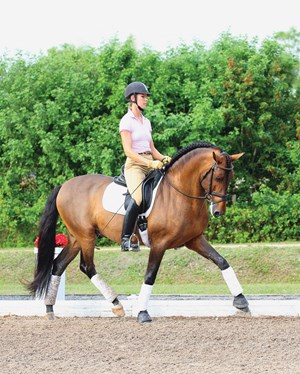
A clue that tells you you’re not using your inside leg enough happens when you feel like you want to pull your inside rein to the outside. In essence, the inside rein is trying to do the job of the inside leg. It tries to prevent the shoulders from falling in because the inside leg isn’t pushing the horse’s barrel out.
For this reason, to make the inside leg work, I often ask students to hold their inside hand in all the time. Be sure to not pull the hand back, only in. It should rotate like a crane with your elbow as the lever. It should put no additional pressure on the horse’s mouth, just eliminate any pressure the rein is putting on the shoulders.
Keep in mind, this is only an exercise that gets your inside leg to do its job. If you can bring your inside hand in for long periods without losing the bend, it proves your inside leg is doing its job, so you don’t always have to keep it there. You simply should always be able to.
This is particularly challenging in half passes or pirouettes where the horse moves to or around the inside leg. The inside hand just begs to pull to the outside because it doesn’t want to push when the horse is supposed to move toward it; it’s counter-intuitive.
With all of the exercises I’ve suggested before, the haunches-in to shoulder-in, the leg yield to half pass, etc., keeping the inside rein in is a great additional tool to ensure that the rider’s inside leg stays honest.
Courtney King-Dye represented the United States at the 2008 Olympic Games riding Harmony’s Mythilus and at two World Cups riding Idocus. She is a U.S. Dressage Federation (USDF) Certified Instructor through Fourth Level and USDF gold medalist (ckddressage.com).











